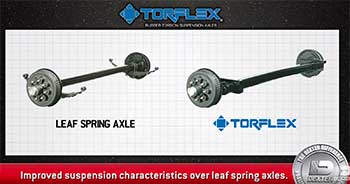All About Trailer Axles
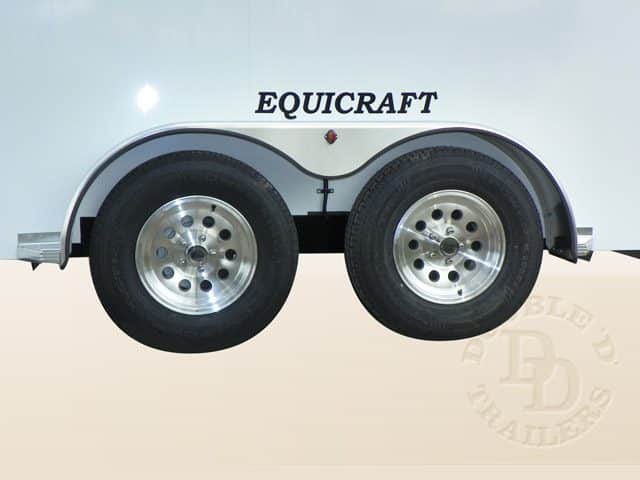
Your horse trailer axles might not be your first concern when designing a new custom horse trailer. It’s a lot more fun to think about the trailer layout, the living quarters, and the type of paint job you’re going to apply. But having suitable axles for your intended load can make a big difference in the quality of your ride.
In this article, we’re going to talk about “everything axles!” We’ll help you understand the basic math behind choosing the right axle capacity and explain the problems with going too heavy or too light. Ultimately, the right type of axles on your trailer will make a big difference in how your trailer performs the next time you drive down that back country roadway.
The Problem with Having Over Rated Axles
Many people are tempted to request very heavy duty axles to cover all possibilities. After all -- bigger is better, right? Actually, there are some problems with choosing too high capacity axles. Here’s why…
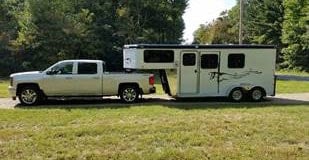 Years ago, we had a customer purchase a small 2 horse gooseneck trailer with a very small dressing room. The trailer weight was only 4,500 lbs so he’d be hauling around 6,000 lbs with two horses on board.
Years ago, we had a customer purchase a small 2 horse gooseneck trailer with a very small dressing room. The trailer weight was only 4,500 lbs so he’d be hauling around 6,000 lbs with two horses on board.
This customer insisted on us installing 12,000 lbs axles with 16” tires. He explained that he often traveled on very long trips and had experienced tire and axle failure in the past with other trailers. We strongly recommended against this course of action, but we eventually built the trailer to meet his requests.
Can you guess what happened?
Yup… the customer picked up the trailer, paid for it, and within ONE hour was back at our shop after never making it home. “This thing is so bouncy, there’s NO WAY we could haul a horse it in!”
In response, Double D Trailers owner Brad Heath stifled a “Duh!” and agreed to fix the problem. After switching the suspension to a 7,000 lbs (rather than the overrated 12,000 lbs), the customer left happy with a smooth riding trailer.
What can you learn from this lesson? Having a suspension with overrated axles can actually do you more harm than good!
The Problem with Having Under Rated Axles
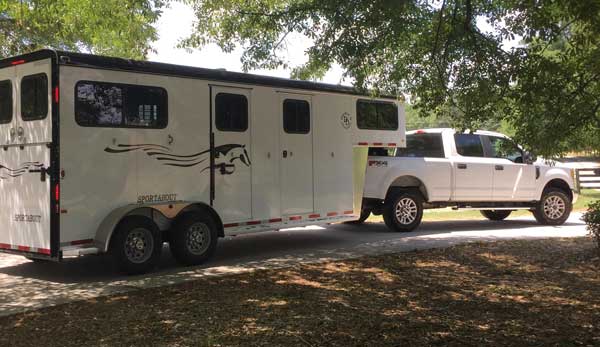 If too heavy of a suspension is bad, too light of a suspension can be equally troublesome. We once had a customer who purchased a SafeTack Reverse 2 Horse Gooseneck trailer. It was extra wide and extra tall to fit her Warmbloods. We installed the standard 7,000 lbs suspension which was appropriate for her trailer’s final weight when fully loaded.
If too heavy of a suspension is bad, too light of a suspension can be equally troublesome. We once had a customer who purchased a SafeTack Reverse 2 Horse Gooseneck trailer. It was extra wide and extra tall to fit her Warmbloods. We installed the standard 7,000 lbs suspension which was appropriate for her trailer’s final weight when fully loaded.
This customer loved her trailer and used it for many years. Then, she decided to take it to an interior conversion company to install a new (and very heavy) living quarters to replace her dressing room. One day, we received an email from her. After the living quarters were installed, the tires were scrubbing up against the trailer fenders. Yikes!
Thankfully this was noticed before any damage or axle failures occurred. We ended up shipping out a 10,400 lbs suspension to a local repair shop so her trailer could handle its new heavier load.
So, if too heavy and too light are BOTH a problem, how can you find the right axle type for your new trailer? Let’s dive into the math a bit. (Don’t worry… this is simple stuff.)
How to Calculate Your Trailer’s Needed Axle Strength
To start, there are a few important towing terms we need you explain. The first is Gross Vehicle Weight (GVW) and the second is Gross Axle Weight (GAW).
- The GVW is the weight of the trailer, including anticipated cargo. So, if your future two horse trailer weighs about 6,000 pounds, your two horses each weigh 1,000 pounds and you intend to carry 1,000 pounds of hay and supplies when you travel, your GVW would be 9,000 pounds.
- The GAW is a number that indicates how much of the weight of your load will be distributed to the trailer axles. For most trailers, that’s going to be 75 to 80 percent of the total weight. If you multiply the GVW by 75 percent, you get 6,750 pounds, meaning each of your two trailer axles should be rated at just over 3,375 pounds.
When customers are looking at trailers, they often ask about beefing up their axles. A lot of folks request 7,000 lbs axles and 16 G –rated tires thinking it will help them avoid tire blow out or axle failure.
Although it would seem that bigger would be better, the fact is that your trailer needs to be able to give a little to provide the smoothest ride. When axles are too high capacity, they’re also stiffer. Overkill axles mean a bouncy, stiff ride that can injure your horse and make it hard to keep your trailer on a bumpy road
If your horse trailer is too light because you habitually haul it unloaded or only partially loaded, you’ll need to carry more weight to improve the ride or have the axles changed to better reflect the reality of your hauls.
On the other hand, if you go with axles that are way too light to save money or because you underestimate how much you’ll be hauling, road heat will cause the overloaded axles to chronically overheat. Overly light axles may need frequent repairs and you’ll probably go through a lot of tires if you travel very much with your horses.
Think of Trailer Axles Like Your Pick-Up Truck

He goes on to explain, “With a ¾ ton vehicle, the suspension is stiffer meaning it can haul more load. So, when empty, you feel more bumps on the road. This is like a trailer that has too heavy of a suspension system.”
So, with your horse trailer, you want it to ride smoothly like the half ton, but have enough free capacity not to overload the suspension.
Does The Brand of Axle Matter?
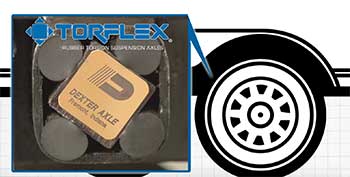
Cushion is provided by a heat-treated steel bar which is surrounded by four rubber cords. These cords cushion the bar and provide shock absorption as the wheel moves over the ground.
This system uses four rubber cords so it out performs competitor brands that only use three. Plus, we like this better than leaf spring axles because they do not have metal-on-metal moving parts that wear out. The Torflex brand provides a quieter and smoother ride.
How Does this All Relate to Trailer Tires?
Your horse trailer tires work under a similar philosophy as your trailer axles. Again, if you have tires that are too high capacity for the amount of weight you plan to haul, you’ll have a bumpier ride. If you have tires that are too low capacity you will be risking tire blow out.
One final connection… you need to make sure your axles and tires work well together to handle your trailer’s load. If you have an axle rated to haul 6,000 lbs and tires that are only rated for 2,500 lbs each you may have a problem. The entire “suspension” can only handle a maximum of 5,000 lbs without overloading the tires.
As you can see, designing a well-built custom horse trailer is about more than living quarters and paint jobs. There are some technical issues to consider so your trailer is safe to haul on the road.
Lucky for you, we make it our businesses to help customers make these decisions so they end up with a trailer that is matched for their needs and habits. If you have any questions about choosing the right trailer axles, reach out to Brad today. He’s happy to help.

